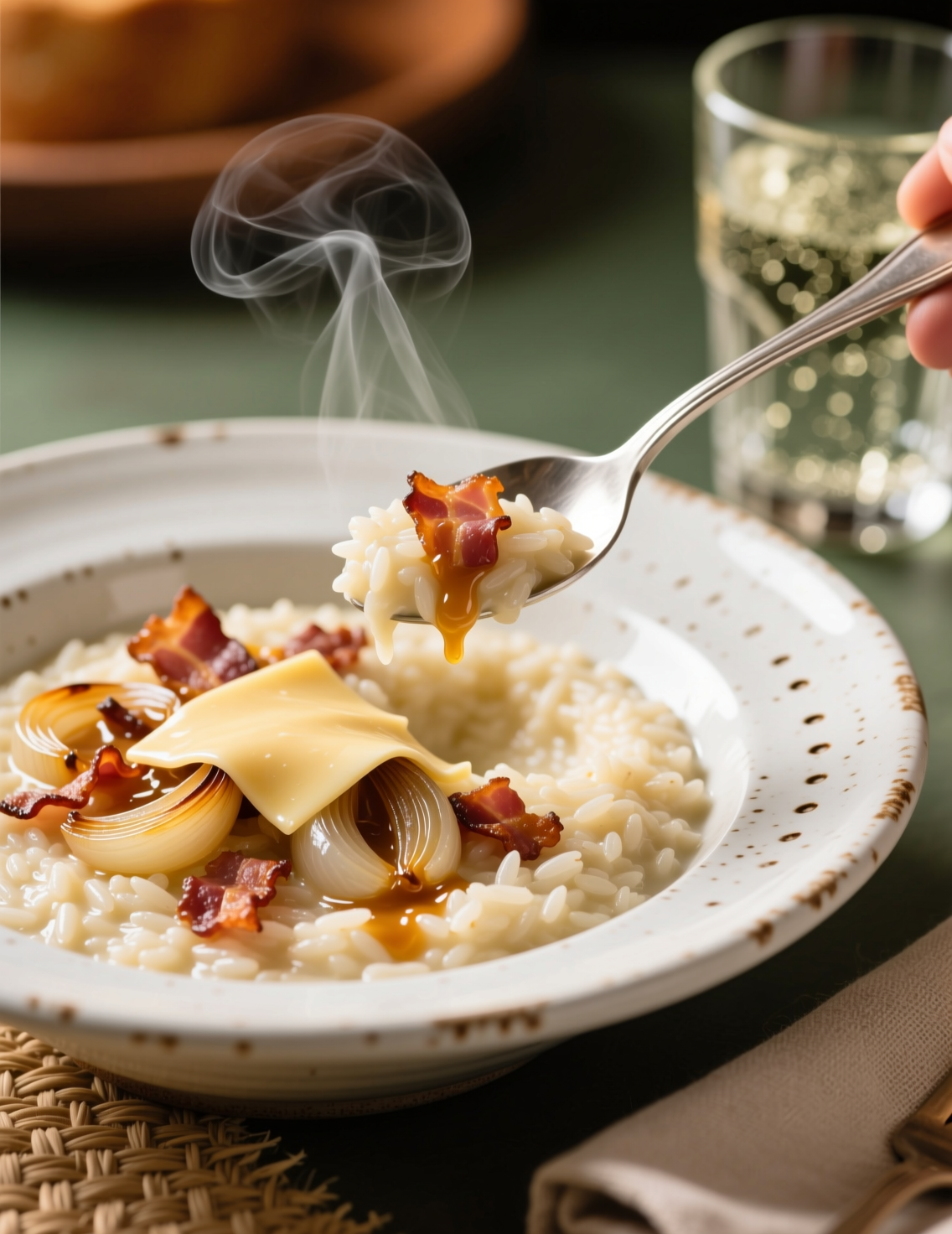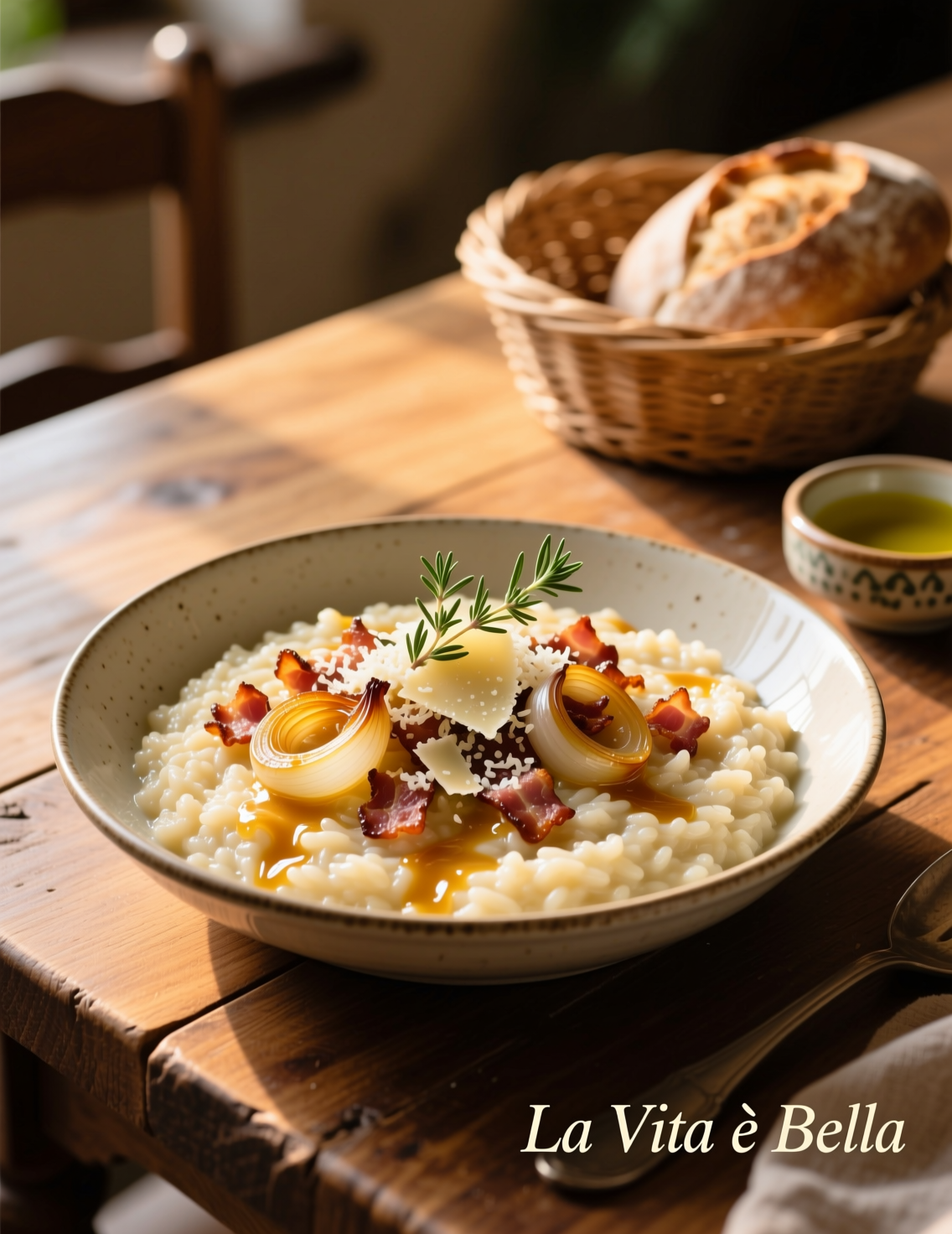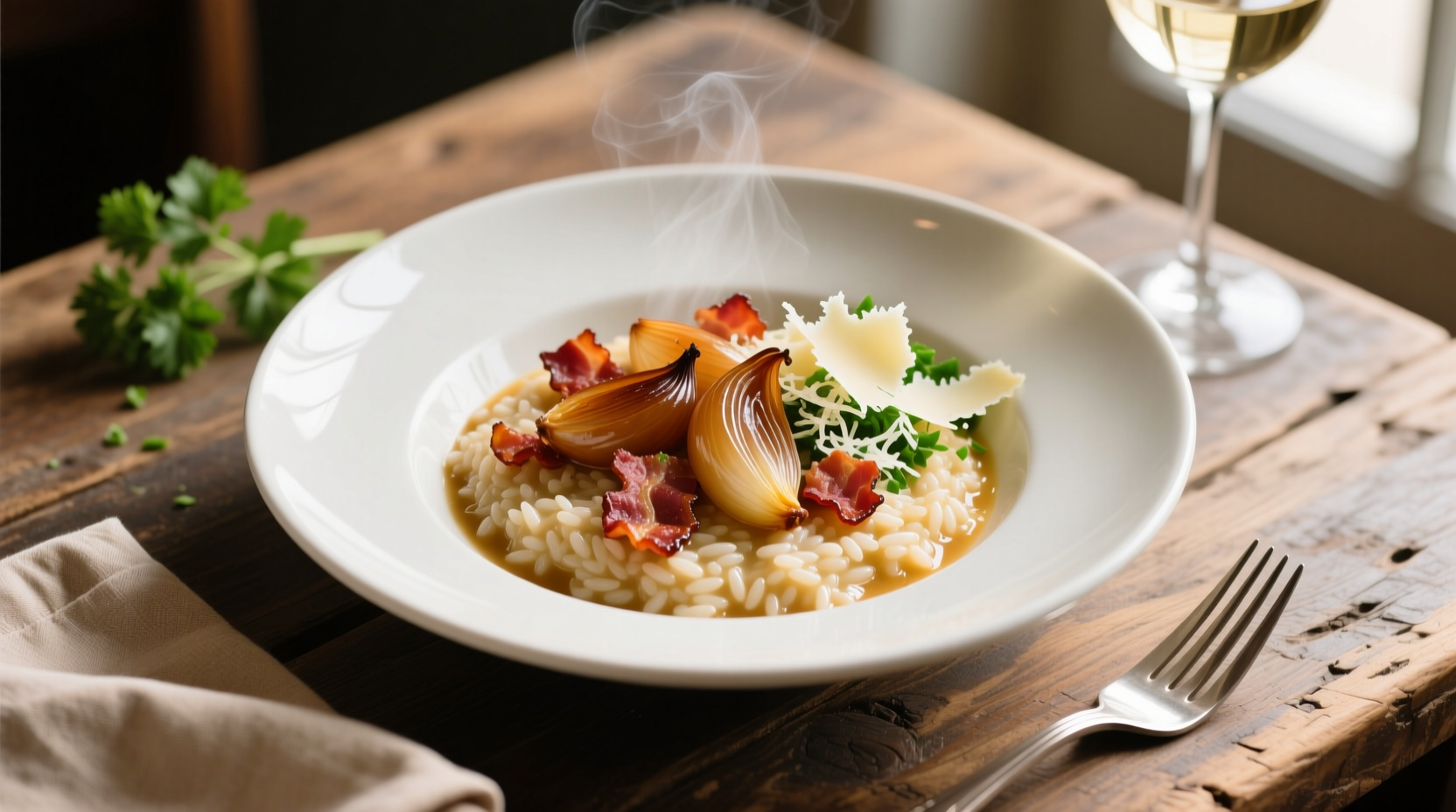Risotto has a reputation, sometimes deserved, sometimes exaggerated, of being intimidating. Yet when you break it down, it’s just rice treated with more respect than usual. Caramelized onion, bacon, and Parmesan risotto is not just a dish—it’s a performance where timing, heat, and patience play lead roles. For 4 servings, the craft lies not only in the stirring but in understanding why each stir matters. Let’s explore the recipe in depth, but more importantly, let’s understand why the dish works the way it does.
Why Risotto Matters in the Professional Kitchen
Risotto is an Italian classic that tests both skill and restraint. You can’t fake risotto; you either build flavor patiently or end up with rice soup. In Northern Italy, where Arborio and Carnaroli rice varieties dominate, risotto is treated like art, and rightly so. Professionals use it as a training ground for junior chefs because it forces them to focus on fundamentals: heat management, knife work, and palate.
Studies in consumer dining trends show that comfort dishes with elevated flavors—like risotto with savory inclusions such as bacon and Parmesan—are consistently high on restaurant menus. According to the National Restaurant Association (2023), dishes that combine indulgence with familiarity see a 12% higher reorder rate. Risotto is exactly that: homey yet elevated, indulgent but balanced.
The Ingredients at the Core
For 4 servings, the ingredient list looks deceptively simple. But simplicity hides detail.
- Arborio rice – 1 ½ cups. Short-grain, starchy, the backbone of risotto. Some prefer Carnaroli for its firmer bite, but Arborio is more accessible.
- Yellow onions – 2 medium. Caramelized slowly to bring deep sweetness.
- Bacon – 6 thick slices. Smoked or unsmoked? Smoked bacon lends richness, unsmoked keeps flavors cleaner.
- Parmesan cheese – 1 cup, finely grated. True Parmigiano-Reggiano if possible, not pre-shredded dust.
- Chicken or vegetable stock – 5 cups, kept hot on the stove. Heat is not optional; cold stock ruins the rice texture.
- Butter – 3 tbsp. Used both at the start and finish, known as mantecatura, for gloss and creaminess.
- Olive oil – 1 tbsp, for sautéing.
- White wine – ½ cup, dry. Acidity balances the fat.
- Salt and pepper – to taste.
Optional but wise: fresh thyme leaves or a few drops of balsamic glaze for garnish.

The Science of Caramelization and Bacon
Caramelizing onions isn’t a quick errand. If someone tells you they did it in 10 minutes, they either lied or burned them. True caramelization takes 30–40 minutes on medium-low heat. The natural sugars slowly transform, building complexity. Onions lose sharpness and become sweet-savory, almost jammy. This sweetness balances the saltiness of bacon and Parmesan.
Bacon, on the other hand, provides both fat and umami. Crisping bacon in the pan before starting the risotto leaves behind rendered fat, a gift that infuses the rice with smoky depth. Studies in food chemistry show that umami-rich proteins like bacon or Parmesan amplify perception of other flavors by up to 30%. That’s why risotto with both ingredients feels fuller, rounder, more complete.
Step-by-Step: Cooking the Risotto
- Prepare the base. Chop onions thin. Cook them with a tablespoon of olive oil and one of butter over medium-low heat. Stir every few minutes, don’t rush. After 30 minutes, they should be golden brown, soft, and sweet. Remove and set aside.
- Cook the bacon. In the same pan, add bacon slices. Render fat slowly, don’t just fry hard. Crisp edges but keep meat chewy. Remove, crumble, reserve the fat.
- Toast the rice. Add Arborio rice into that bacon fat, plus a touch of butter. Stir for 2 minutes until grains turn translucent at edges. This coats each kernel, preventing mush. Italian chefs call this step tostatura, and it’s crucial.
- Deglaze with wine. Pour in the white wine. Stir until nearly evaporated. This acidity lifts the flavors stuck at the bottom of the pan.
- Add stock, one ladle at a time. Here’s where patience lives. Add hot stock, stir until absorbed, repeat. Don’t dump it all in. This gradual absorption releases starch slowly, creating creaminess without cream.
- Fold in the onions. Halfway through cooking (around 10 minutes in), add the caramelized onions back. Their sweetness integrates rather than sits on top.
- Finish with bacon and Parmesan. At the last few minutes, stir in the bacon, Parmesan, and final knob of butter. Adjust salt and pepper. Rest for 2 minutes before serving, so flavors settle.
Common Mistakes Professionals Avoid
Many cooks, even experienced ones, get caught in traps. One trap is stirring too aggressively. Risotto needs movement but not abuse. Stir gently; too much agitation makes it gluey, not creamy.
Another mistake is adding stock that isn’t hot. Cold stock shocks the rice, halting starch release, resulting in uneven texture. Professionals keep a saucepan of stock simmering next to the risotto pan, no exceptions.
Then there’s the cheese. Using cheap pre-grated Parmesan that contains cellulose anti-caking agents will muddy the flavor and grain the texture. True Parmigiano-Reggiano melts into silk. It costs more but makes the dish sing.
Flavor Layering and Balance
Why does caramelized onion, bacon, and Parmesan risotto feel so complete? Because it touches all five primary tastes.
- Sweetness from caramelized onion.
- Saltiness from bacon and cheese.
- Umami from bacon, Parmesan, and the rice starch.
- Acidity from wine.
- Bitterness faintly from browned edges of bacon and onion.
This balance keeps the palate from tiring. Without onions, it’s too salty. Without bacon, it lacks depth. Without Parmesan, it loses creaminess. Together, they form harmony.
Variations for Professionals
A professional kitchen rarely sticks to just one version. Some riffs worth noting:
- Replace bacon with pancetta for a purer Italian feel.
- Add sautéed mushrooms for earthiness. Porcini or chanterelles work beautifully.
- Drizzle truffle oil or shave truffles at finish for luxury dining.
- For vegetarians, replace bacon with smoked paprika and toasted pine nuts.
These variations adapt the dish to season, clientele, or price point. Restaurants often play with base risotto but keep the onion-Parmesan duo as a constant because it guarantees comfort.

Texture and Presentation
Risotto should not stand like a brick on a plate, nor should it run like soup. In Italy, chefs call the correct texture all’onda—like waves. The rice should spread slightly when plated but still hold body. Professionals serve it on wide, shallow plates rather than deep bowls, allowing steam to escape and texture to hold longer.
Garnishing matters too. A sprinkle of fresh thyme, a twist of black pepper, maybe a few Parmesan shards. Presentation elevates perception. Diners eat with eyes first, and risotto, while beige, can still look luxurious.
Nutritional Insights
For 4 servings, each portion is about 500–550 calories depending on fat content in bacon and amount of cheese. Carbohydrates dominate (from rice), protein comes from bacon and cheese, while fats balance from butter and Parmesan.
Interestingly, Parmesan is one of the richest natural sources of glutamates, the compounds that trigger umami. Research by the Journal of Food Science shows Parmesan contains nearly 1,200 mg glutamate per 100 g, higher than soy sauce or anchovies. This explains its magic in risotto.
Pairing with Wine
A dish this rich demands balance from the glass. White wines with acidity—like Pinot Grigio, Sauvignon Blanc, or even a crisp Chardonnay—cut through the fat. Red wines are trickier, but a light-bodied red like Pinot Noir works. Professionals often choose wines from Northern Italy, aligning dish and terroir, which pleases purists and sommeliers alike.
Storage and Reheating
Risotto doesn’t store gracefully. Starch solidifies as it cools, tightening texture. Professionals rarely serve reheated risotto at restaurants. However, leftovers can be transformed into arancini, fried risotto balls, a staple in Sicilian cuisine. This way nothing is wasted, and you get a new dish altogether.
Why This Dish Belongs in Your Rotation
For professional chefs, this risotto represents more than comfort food. It’s a chance to showcase technique, to highlight balance, and to create something indulgent yet precise. For home cooks, it’s proof that patience in the pan leads to luxury at the table.
Risotto with caramelized onion, bacon, and Parmesan is a reminder: some dishes demand you slow down. And slowing down, especially in a busy kitchen, is a skill worth learning.
Conclusion
Caramelized onion, bacon, and Parmesan risotto is not just another rice dish. It’s a lesson in heat, patience, and flavor layering. With onions caramelized to deep sweetness, bacon adding smoky punch, and Parmesan binding everything into creamy waves, it serves as both comfort and craft.
For professionals, this recipe is a training tool and a menu staple. For diners, it’s indulgence that feels earned. The next time someone tells you risotto is too hard, invite them to stir a pot with you. After the first creamy spoonful, the myth will vanish quicker than the risotto itself.
FAQs
What type of rice is best for caramelized onion, bacon, and Parmesan risotto?
Arborio or Carnaroli rice works best because of their high starch content.
How long does it take to caramelize onions properly?
It usually takes 30–40 minutes on medium-low heat for true caramelization.
Can I use pre-grated Parmesan cheese?
No, fresh Parmigiano-Reggiano is recommended for better flavor and texture.
Why must the stock be kept hot while cooking risotto?
Hot stock ensures even starch release and prevents rice from becoming unevenly cooked.
Can bacon be replaced in this recipe?
Yes, pancetta, smoked ham, or even vegetarian options like smoked paprika can be used.
What wine pairs well with this risotto?
Crisp white wines like Pinot Grigio or Sauvignon Blanc balance the dish best.
How can leftovers be used if risotto doesn’t reheat well?
They can be turned into arancini, crispy fried risotto balls.
What’s the ideal texture for risotto?
It should be all’onda, creamy and flowing like waves, not stiff or soupy.
Is this risotto gluten-free?
Yes, it’s naturally gluten-free as long as your stock and bacon are gluten-free.
How many servings does this recipe make?
The recipe is designed to serve 4 generous portions.

Mariana is a passionate home cook who creates delicious, easy-to-follow recipes for busy people. From energizing breakfasts to satisfying dinners and indulgent desserts, her dishes are designed to fuel both your body and hustle.
When she’s not in the kitchen, she’s exploring new flavors and dreaming up her next recipe to share with the Foodie Hustle community.

